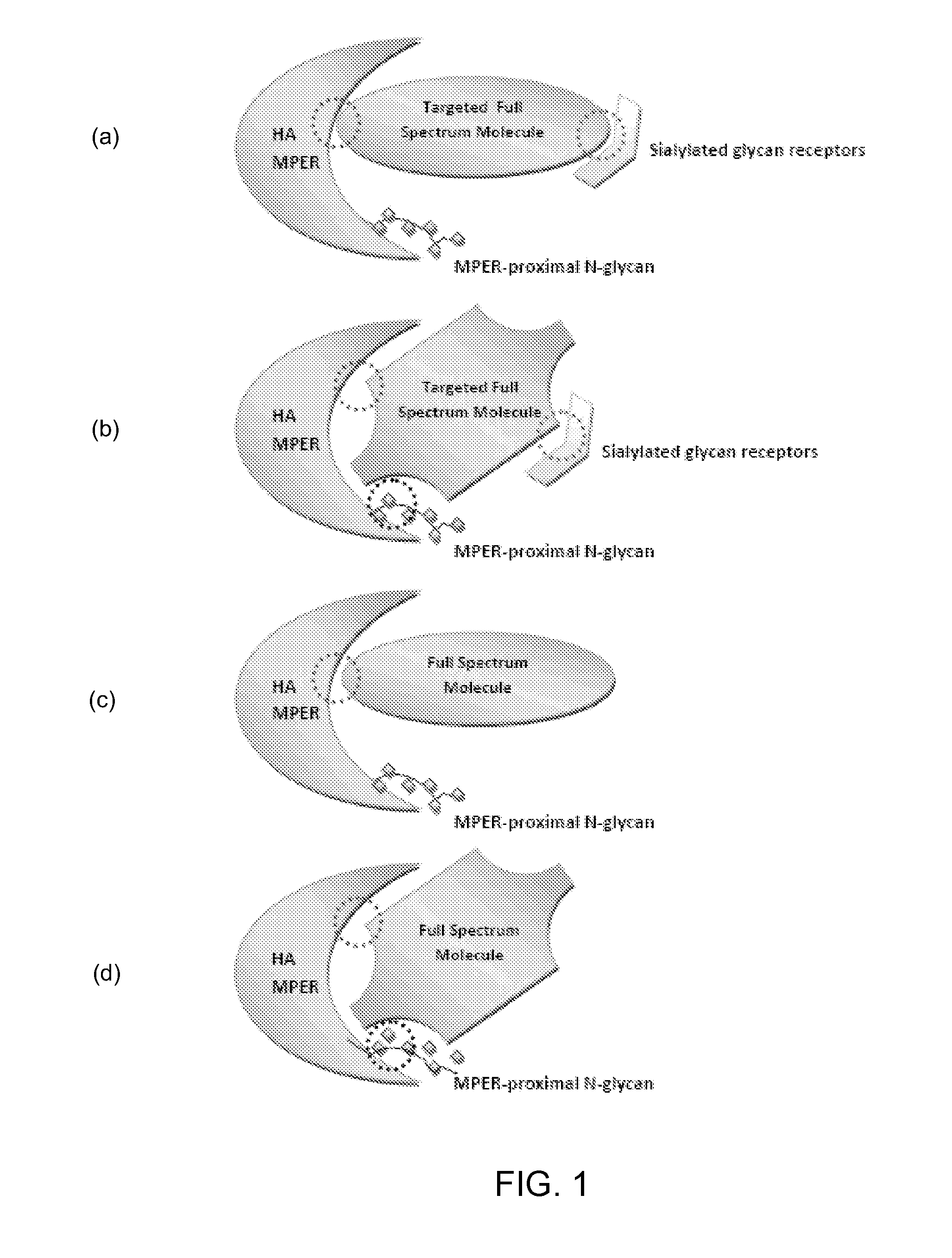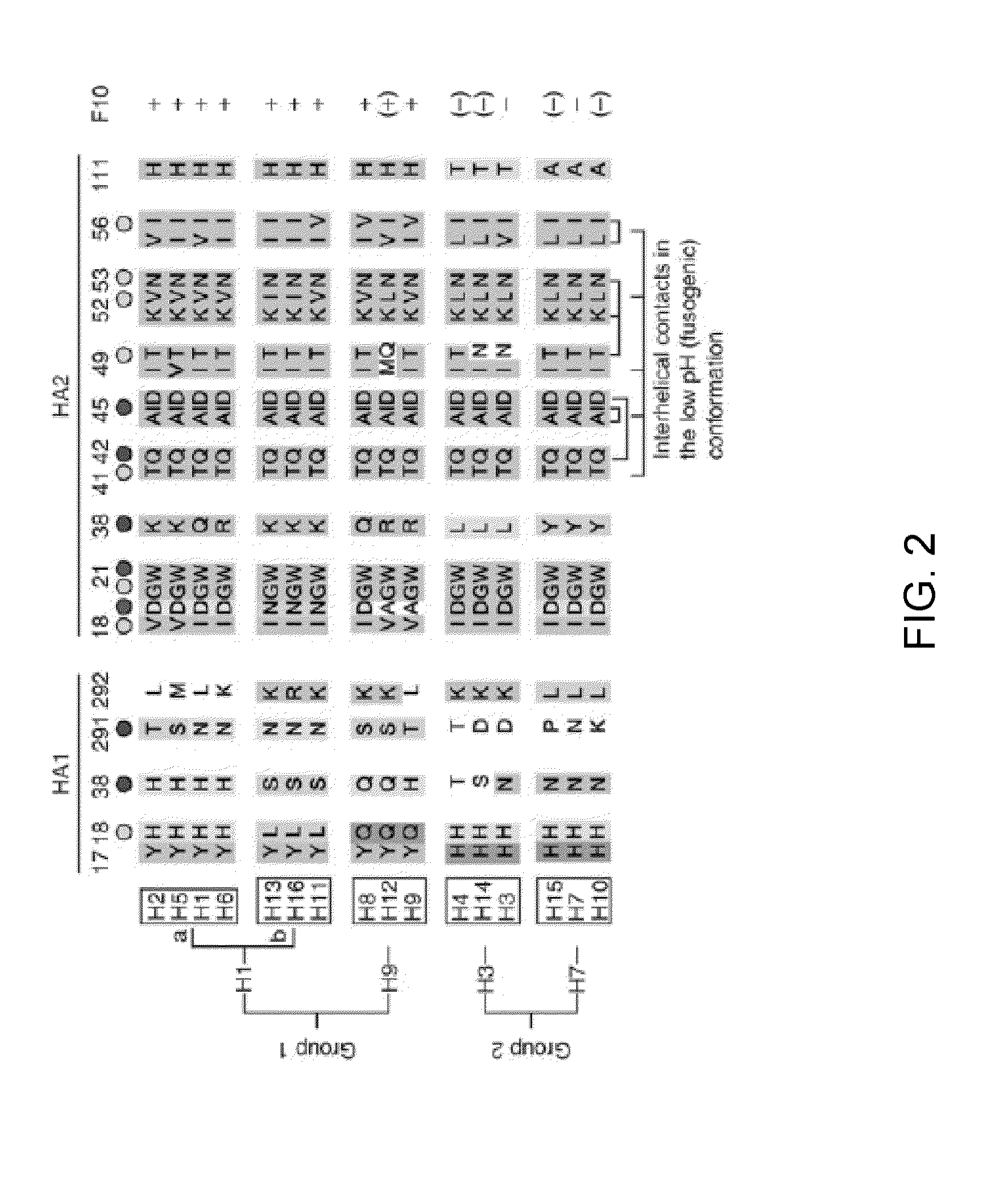Engineered polypeptide agents for targeted broad spectrum influenza neutralization
a broad spectrum, polypeptide technology, applied in the direction of peptides, peptides, aerosol delivery, etc., can solve the problems of less effective seasonal flu vaccines and 300,000 deaths annually
- Summary
- Abstract
- Description
- Claims
- Application Information
AI Technical Summary
Benefits of technology
Problems solved by technology
Method used
Image
Examples
example 1
Design of Infold Agents
[0239]The present example illustrates the design of infold agents to bind to specific regions on an HA polypeptide.
[0240]One exemplary infold sequence was designed against the HA binding interface (FIG. 6). These interactions revealed several potentially stabilizing contacts with both the head (HA-1) and stalk (HA-2) domains of HA (Table 10). It is seen that one of the regions of the designed protein has the desired stabilizing hydrophobic contacts and hydrogen bonds with both HA-1 and HA-2 domains, while another prominent region has stabilizing hydrophobic interactions primarily with HA-1, while yet another region has stabilizing hydrophobic interactions primarily with HA-2. Thus, the designed infold protein under consideration is expected to bind at the stalk-head interface of the HA-1 and HA-2 domains. Furthermore, as expected, the designed proteins are seen to accommodate the N-glycosylation in the HA MPER region owing to their significantly smaller volume...
example 2
Infold Agents Bind HA Polypeptides
[0243]The present example illustrates binding of infold agents to HA polypeptide in an in vitro binding assay.
[0244]Maxisorp 96-well plate wells were coated with 0.2 μg an HA polypeptide of different subtypes (H1, H3, H5, H7 and H9) and left overnight at 4° C. The HA polypeptide coated plates were washed thrice with PBS and blocked with 1% BSA in PBST. Different concentrations of infold agents along with C179 antibody (control) were added to HA polypeptide coated wells and the plate was incubated at RT for 2 hrs. The plate was washed thrice with PBST and the wells containing infold agents were incubated with mouse-anti-6× His antibody (1:1000 dilution) for 1 hr at RT. The plates were washed thrice with PBST and all wells were incubated with goat-anti-mouse HRP antibody for 1 hr at RT. Post-incubation the wells were washes with PBST and the bound HRP was measured using TMB substrate. TMB substrate was added to the wells, incubated for 3 minutes, foll...
example 3
Binding Affinity Between Infold Agents and the Targets of an Infold Agent
[0246]The present example shows a calculation of binding affinity, as represented as a dissociation constant (Kd), between an infold agent and the target of the infold agent. In this example, the infold agent is an exemplary infold agent and the target of the infold agent is an HA polypeptide.
[0247]Binding affinity between the exemplary infold agent and an HA polypeptide is a function of the concentrations of both the infold agent and the HA polypeptide. In the present example, the binding affinity is quantitatively described using dissociation constant (Kd). An example of how to measure the dissociation constant is described below.
[0248]HA polypeptide coated plates were used to perform ELISA assays with an exemplary infold agent as described previously. The measured absorbance at 450 nm was used to calculate the fractional saturation of the receptor. The fractional saturation was plotted as a function of molar...
PUM
| Property | Measurement | Unit |
|---|---|---|
| real time PCR | aaaaa | aaaaa |
| pharmaceutical composition | aaaaa | aaaaa |
| affinity | aaaaa | aaaaa |
Abstract
Description
Claims
Application Information
 Login to View More
Login to View More - R&D
- Intellectual Property
- Life Sciences
- Materials
- Tech Scout
- Unparalleled Data Quality
- Higher Quality Content
- 60% Fewer Hallucinations
Browse by: Latest US Patents, China's latest patents, Technical Efficacy Thesaurus, Application Domain, Technology Topic, Popular Technical Reports.
© 2025 PatSnap. All rights reserved.Legal|Privacy policy|Modern Slavery Act Transparency Statement|Sitemap|About US| Contact US: help@patsnap.com



